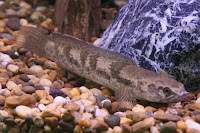Snakeheads are thrust-feeders which consume plankton, aquatic insects, and mollusks when small. When adult, they mostly feed on other fish such as carp, or on frogs. In rare cases small mammals such as rats are taken.
The Snakeheads are members of the freshwater perciform fish family Channidae. These elongated predatory fish are distinguished by a long dorsal fin, large mouth and shiny teeth. They breathe air with a suprabranchial organ, a primitive form of a labyrinth organ.
The size of the snakehead species differs greatly. "Dwarf snakeheads" like Channa gachua grow to 10 inches (25 cm). Most snakeheads grow up to 2 or 3 feet (60–90 cm). Two species (Channa marulius and Channa micropeltes) can reach a length of more than 1 meter and a weight of more than 6 kg. The giant snakehead (Channa micropeltes) is native throughout Asia, and is the most aggressive snakehead. They can grow to around 1 meter in length.
Invasive Species And Cause Ecological Damage
 Snakeheads can become invasive species and cause ecological damage because they are top-level predators, meaning that they have no natural enemies outside of their native environment. Not only can they breathe atmospheric air, but they can also survive on land for up to four days, provided they are wet, and are known to migrate up to 1/4 mile on wet land to other bodies of water by wriggling with their body and fins.
Snakeheads can become invasive species and cause ecological damage because they are top-level predators, meaning that they have no natural enemies outside of their native environment. Not only can they breathe atmospheric air, but they can also survive on land for up to four days, provided they are wet, and are known to migrate up to 1/4 mile on wet land to other bodies of water by wriggling with their body and fins.National Geographic has referred to snakeheads as "Fishzilla" and the National Geographic Channel reports that the "Northern Snakehead reaches sexual maturity by age 2 or 3. Each spawning-age female can release up to 15,000 eggs at once. Snakeheads can mate as often as five times a year. This means in just two years, a single female can release up to 150,000 eggs"


No comments:
Post a Comment